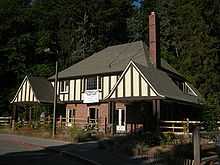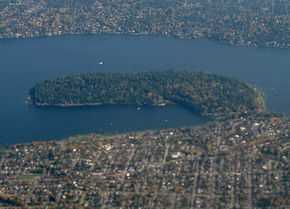Seward Park (Seattle)
| Seward Park | |
|---|---|
|
Aerial view of Seward Park from the west, with Mercer Island on top and Seattle on bottom. | |
 Location of Seward Park in Seattle | |
| Type | Urban park |
| Location | Seattle, Washington |
| Coordinates | 47°33′22″N 122°15′04″W / 47.556°N 122.251°WCoordinates: 47°33′22″N 122°15′04″W / 47.556°N 122.251°W |
| Area | 300 acres (120 ha; 0.47 sq mi) |
| Established | 1911 |
| Founder | E. O. Schwagerl |
| Designer | Olmsted Brothers |
| Operated by | City of Seattle |
| Open | 6 am – 10 pm |
| Website | Seattle Parks and Recreation: Seward Park |
Seward Park is a municipal park which covers 300 acres (120 ha; 0.47 sq mi). It is located in southeast Seattle, Washington, U.S.A in the neighborhood of the same name. The park occupies all of Bailey Peninsula, a forested peninsula and former island that juts into Lake Washington. It contains one of the last surviving tracts of old-growth forest within the city of Seattle. The park is named for former U.S. Secretary of State William Seward.
Geography
One approaches the park from the north by Lake Washington Boulevard S, from the south by Seward Park Avenue S., or from the west by S Orcas Street. The main parking lot and a tennis court are located in the southwest corner. The most commonly used trail is a car-free loop around the park. It is flat and 2.4 miles long ( 3.8 km). The perimeter trail was repaved in 2007. Other trails run through the interior, including a few car-accessible roads that lead to amenities including an amphitheater and picnic area. Seward Park features numerous small beaches, the largest one on its southwest side, as well as a playground and an arts center.
The 300 acres (121 ha) of Seward Park have about a 120 acre (48.6 ha) surviving remnant of old growth forest, providing a glimpse of what some of the lake shore looked like before the city of Seattle. With trees older than 250 years and many less than 200, the Seward Park forest is relatively young (the forests of Seattle before the city was fully mature, were up through 1,000–2,000 years old).[1]
History

The area has been inhabited since the end of the last glacial period (c. 8000 BCE—10,000 years ago). The People of the Large Lake (Xacuabš or hah-chu-AHBSH, today the Duwamish tribe) had resource sites; villages were nearby. The Duwamish called Bailey Peninsula "Noses" (Lushootseed: squbáqst). Before the completion of the Lake Washington Ship Canal in 1916 lowered the level of Lake Washington, the peninsula was an island with points, or "noses", at the north and south ends.[2]
The purchase of the park was suggested as early as 1892, but was sidelined due to its distance from what was then the city. However, the Olmsted Brothers assimilated it into its plan for Seattle parks, and the city of Seattle bought Bailey Peninsula in 1911 for $322,000, and named the park after William H. Seward, former United States Secretary of State, of Alaska Purchase fame.
At the entrance to the park, in a wooded island filled with flowers between the circular entrance and exit road, there is a little-known monument: a taiko-gata stone lantern, a gift of friendship from the City of Yokohama, Japan, to the City of Seattle, given in 1930 in gratitude to Seattle's assistance to Yokohama after the Great Kanto Earthquake of 1923.
Since at least early July, 2004, the park has become a home to wild rabbits and a growing colony of feral Peruvian conures (parrots, either the Chapman's mitred or the scarlet-fronted), who were released into the wild by their owners (or some escaped). They fly between Seward Park and Maple Leaf in northeast Seattle.[3] The park is also home to two nesting pairs of bald eagles, who can frequently be seen flying over Lake Washington and diving to the water's surface to catch fish and ducks.
Renovation on the Tudor-style house at the entrance to Seward Park—originally the Seward Park Inn, a Seattle city landmark—was completed early in 2008 and is now the Seward Park Environmental & Audubon Center. Programming at the Center and in the park includes school, youth, community, arts in the environment, and special events. The Center also includes exhibits, an extensive library, a laboratory, and a small gift shop.
Description
Seward Park offers at least five unique experiences.
The first Seward Park experience is the beach on Andrews' Bay. Flanked by a broad lawn and with full facilities, it is one of Seattle's several lakeshore beaches.
On the other side of this beach is the second experience: a playground, tennis courts, and several large parking lots. This is the most social part of Seward Park, and the lot often features neighboring residents sometimes throw impromptu parties in this area of the park.
The third experience is in the "upper lots," which provide parking for a large picnic area and an outdoor amphitheatre. Civic events are often held in the amphitheatre, which has beautiful views of the old-growth forest, and it has become a well-known spot to celebrate that is the diversity of both Seattle and its South End. These parking lots can also host impromptu parties.
The fourth experience is the old growth forest itself. Granite trail markers help hikers navigate.
The fifth experience is the paved perimeter of the park, which is a favorite place for neighbors and visitors alike to walk, run, bike, and blade. The permimeter reminds its user of the vast metropolis that is Seattle, since it affords to the south of the park (1) a view of Mount Rainier dominating South Lake Washington, as well as Boeing plants; to the east of the park (2) fine view of Mercer Island; north of the park (3) the downtown skyscrapers jutting out over the Mount Baker/Leschi ridge, (4) the busy hum of I-90, and (5), the Jefferson Park golf course, where famous local golfer Fred Couples got his start as a boy growing up on Beacon Hill; and finally, to the west of the park, the many fine homes climbing the "ridge with no name" that flanks the entire western side of the park (the southernmost peak of this ridge is sometimes referred to as "Graham Hill," and has a school named after it, but the name has never really taken, since the ridge extends well beyond the natural boundaries of Graham Hill).
References
- ↑ (1) Sherwood
(2) Talbert (2006-05-01, "Magnificent") - ↑ Thrush, Coll (2007). Native Seattle: Histories from the Crossing-Over Place. University of Washington Press. p. 247. ISBN 0-295-98700-6.
- ↑ (1) "Parrots". BirdWeb, Seattle Audubon Society. 2005. Retrieved 2006-04-21.
(2) Post 02:26, 9 July 2004 (UTC)
Bibliography
- "Seward Park". Seattle Parks and Recreation. not recorded, 2006-08-10. Retrieved not recorded, 2006-08-21. Check date values in:
|date=, |accessdate=(help) - "Seward Park History". Seattle Parks and Recreation. 2003-06-30. Retrieved not recorded, 2006-08-21. Check date values in:
|accessdate=(help) - Sherwood, Don (2003-06-20). "Seward Park" (PDF). PARK HISTORY: Sherwood History Files. Seattle Parks and Recreation. Retrieved 2006-04-21.
- Talbert, Paul (2006-05-01). "The Magnificent Forest". Friends of Seward Park. Archived from the original on 2006-07-17. Retrieved 2006-08-06.
- Talbert, Paul (2006-05-01). "SkEba'kst: The Lake People and Seward Park". The History of Seward Park. SewardPark.org. Archived from the original on 2005-12-14. Retrieved 2006-06-06.
Further reading
- Friends of Seward Park
- "Seward Park", Seattle Parks and Recreation
- Seward Park Environmental & Audubon Center
